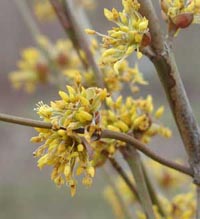Resource Library
Plant of the Week: Cornelian Cherry
The University of Arkansas System Division of Agriculture does not promote, support or recommend plants featured in "Plant of the Week." Please consult your local Extension office for plants suitable for your region.
Plant of the Week
Cornelian Cherry
Latin: Cornus mas

With the arrival of spring, come the first tentative blossoms. For trees, the earliest are the red maples and Cornelian cherry. Both of these trees are early, blooming about two weeks before the always-early deciduous magnolias.
Cornelian cherry (Cornus mas) is not a cherry at all but a kind of dogwood. Though we seldom see it in Arkansas gardens, it grows well here and makes a good show because the competition is scarce in February. It’s native to southern Europe and central Asia.
It grows as a small, low-branched, multi-trunked tree reaching 20 feet with a like spread. Its bark is a peeling, gray-brown color, creating an appealing wintertime display. The leaves are like our native dogwood in shape, but a bit smaller and prone to be cupped. Fall color is usually modest.
Unlike our native dogwood, blossoms on the Cornelian cherry lack a showy bract. The showy portion of our dogwood is a modified leaf - called a bract - with the true flowers clustered in the center. Cornelian cherry retains a yellowish set of bud scales, but the display is mainly from the dense cluster of yellow flowers.
Individual flowers are small, but they appear in clusters as large as a nickel. Because it is so cool in February, blooms remain attractive for about three weeks. Lacking competition, they always make a nice display in the drab, late winter landscape.
The fruit is a bright red, oblong, cherry shaped drupe about three quarters inch long that contains a single seed. Though edible, you’ve got to be pretty hungry or a bird to properly appreciate them.
The name "cornelian" is an adaptation of "cornel," the name used by the Romans for
the tree. The Latin word "cornu" described hard and tough objects such as the horn
of a goat. From
this root word we get cornea (because of the toughness), cornet (because of the shape)
and Cornus, which Linnaeus used when he established the genus name for the dogwoods.
The species epitaph "mas" is a Latin prefix meaning "strong", a reference to the hard, tough wood of the species. This prefix is used in the word "masculine"; in fact in some writings Linnaeus used the Latin name Cornus mascula for cornelian cherry, but he used C. mas first, so it is the official name.
The etymology of the word dogwood, for our native Cornus florida, is not completely clear. One possibility is that it comes from the Middle English word "dag" that referred to a wooden spit made from a shrubby dogwood native to England. These spits were sold on the streets for cooking meat over an open flame.
The word "dag" is itself an adaptation of "daggere," or dagger, as we now know it. The cornelian cherry was recognized for its hard, tough wood that was used for making pikes and maybe wooden daggers. Following this line of reasoning, dogwood is a corruption of the word "dag wood."
The other explanation for the name is that leaves of the English Cornus were used to make a concoction to treat dog mange. A recipe is found in a 17th century herbal, so it’s possible that early English colonists saw the similarity between the plants and adapted the name.
There’s no evidence that leaves of C. florida were ever used as a mange treatment. The epitaph "florida" translates from Latin as "beautiful" and has no connection to the Sunshine State.
Cornelian cherries are hardy throughout Arkansas and make a nice small specimen plant where their early spring blooms can be enjoyed up close. They do best in good soil but are less picky about planting location and soils than our native dogwood. It grows well in full sun or light shade and has considerable drought tolerance once established.
By: Gerald Klingaman, retired
Extension Horticulturist - Ornamentals
Extension News - February 25, 2005
The University of Arkansas System Division of Agriculture does not maintain lists of retail outlets where these plants can be purchased. Please check your local nursery or other retail outlets to ask about the availability of these plants for your growing area.